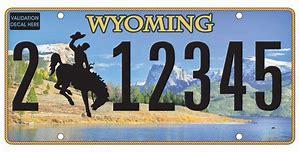
You know this horse. He’s the bucking bronc you see immortalized on the Wyoming state license plate giving that cowboy rider a hard time. The cowboy is believed to be Clayton Danks who rode Steamboat in the Cheyenne Frontier Days rodeo in 1909. He’s one of many to take that fearsome ride. The odds are he was thrown down fast and hard and lucky if he wasn’t seriously injured. He’d never forget that rough ride or the name ‘Steamboat’.
Steamboat is the famously recognized trademark for the State of Wyoming, “The Cowboy State”. In addition to the imagery on the state license plate, the bucking bronco Steamboat logo brands the University of Wyoming “Cowboys” and “Cowgirls” with the rider and horse displayed on their uniforms. The Steamboat bucking horse and rider imagery goes back as far as World War I when the Wyoming National Guard serving in Europe wore the logo patch on their uniforms.
Steamboat was born in Wyoming in 1896. They called him Steamboat because, as the story goes, in an effort by cowboys to get him down for branding and to be gelded (castrated) when he was three years old, he hit his head on the ground so hard that it damaged the cartilage in his nose. Thereafter, because of this injury, the horse wheezed and sputtered constantly. One cowhand said that he sounded like a “steamboat” and the name stuck. The indignity of being gelded probably did not help Steamboat’s overall disposition either. The wheezing steamboat sound became his trademark for the rest of his natural life adding a new dimension to his already powerful and fearsome equine disposition, his muscular strength and stout heart. Steamboat was famously dangerous and one of the most frightening rodeo saddle broncs ever.
There have been many famous horses immortalized throughout history and symbolically branded into our American experience as a powerful life force with which we identify. In sports, the Denver Broncos, Indianapolis Colts, Dallas Mavericks. In mainstream entertainment media, ‘National Velvet’, ‘My friend Flicka’, ‘Fury’’. Roy Rogers‘ ‘Trigger’ (Dale’s ‘Buttercup’), The Lone Ranger’s “Hi Ho, ‘Silver’!” In horse racing there was Seabiscuit and Secretariat. ‘Boy on a Horse’, ‘War Horse’ and many other top-of-mind popular names and imagery both current and past, all characterize the horse as a powerful, heroic figure or used as a mnemonic device depicting a journey of enlightenment through remorse, absolution and repentance.
In the world of PCA (Professional Cowboy Association) Rodeo, however, the bucking bronc represents a dangerous even deadly force of nature in a man against beast contest. These equine demons are not known by name to the average person like our civilized and trained media star horses other than they are mean, powerful and wild. But to the PCA cowboys who ride them, the outfits that breed and train them to buck, and the “pick-up men” who rescue the cowboy rider and retrieve his bronc, they have an intimate knowledge of each horse, his name and characteristics (which usually go hand-in-hand) and the horse’s statistics regarding successful and unsuccessful rides, style and times. Steamboat stood out among the rest as many a cowboy can attest to Steamboat’s talents by their broken bones and bruised bodies trying to hang on to this gyrating tornado beast for 8 seconds.
Steamboat was unique unto himself. There was or will never be another saddle bronc horse like him. Many cowboys had tried for the 8 seconds but most didn’t make it. They would tell stories about Steamboat’s fury and determination to throw a rider, but at the same time never pin him down or kick him once the cowboy was in the dirt. There was a love-hate relationship with that horse that only served to build the legend of Steamboat.
The cowboy riders would tell tactical stories of how Steamboat would always keep his head way down making it difficult to get an edge on him, and how he would twist and turn unique to his formidable body size and structure landing hard on his two front legs jolting the cowboy so hard that one rider said he he thought his teeth would go flying out. One cowboy told of how Steamboat could cross the entire arena in four leaps, kicking and twisting all the way then just stop dead in his tracks ...”then break loose all hell again just when you thought it was over.”
Steamboat died in 1914. He was badly injured in Salt Lake City when he broke from his corral frightened by lightning and a thunder storm. He ran into a barbed wire fence and was cut badly. Steamboat was taken back to Wyoming where he developed blood poisoning and had to be destroyed.
There is a controversy over where and under what circumstance Steamboat’s final resting place was determined. But the one I’ll go with is that Steamboat is buried and memorialized on the Frontier Park fairgrounds in Cheyenne, Wyoming near bucking chute #9. Steamboat was inducted into the National Cowboy Hall of Fame in 1975, the Pro Rodeo Hall of Fame in 1979, and the Cheyenne Frontier Days Hall of Fame in 2002.
So, the next time you see a Wyoming license plate you’ll know the story of Steamboat.
You can read all about this famous horse in ‘Steamboat: Legendary Bucking Horse, His Life and Times and the Cowboys Who Tried to Tame Him’ by Candy and Flossie Moulton https://www.amazon.com/Steamboat-Legendary-Bucking-Horse-Cowboys/dp/0931271193/ref=sr_1_6?keywords=steamboat&qid=1554054055&s=books&sr=1-6
And if you are a fan of Craig Johnson and his Walt Longmire series, you’ll love ‘The Spirit of Steamboat’ https://www.amazon.com/Spirit-Steamboat-Walt-Longmire-Story/dp/0670015784/ref=sr_1_1?keywords=steamboat&qid=1554054055&s=books&sr=1-1
John Kushma is a communication consultant and lives in Logan, Utah.